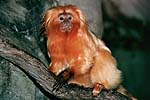The Golden Tamarin

The golden lion tamarin (Leontopithecus rosalia) is a rare and beautiful primate. This small monkey weighs around 11/2 - 2 lbs. and sports a silky, golden coat and a lion-like mane. Its fingers and hands are long and slender and are partially webbed. The tamarin's face is bare of hair.
Tamarins live in scattered remnants of the Atlantic coastal rainforest at elevations from 1500 - 3000 feet. They inhabit abandoned nestholes in the middle level of the forest canopy 30 feet above the forest floor. Each tamarin family maintains a territory of around 100 acres, defined by scent marking and inter-group vocalizations. Their natural enemies are snakes and birds of prey. Tamarins eat fruit, insects and eggs and occasionally catch small lizards, toads, and frogs.
Tamarins tend to be monogamous and remain with the same mate. This breeding pair forms the base for the small family group of three to six tamarins. The adult male and older offspring help the adult female care for her young. She produces one or sometimes two litters a year, usually consisting of twins. Groups communicate in the dense forest with a wide variety of vocalizations.
Several threats combine to make the golden lion tamarin's position in the wild a precarious one. The Atlantic coastal rainforest has been almost completely developed for plantations, cattle grazing and condominiums. Only isolated forest tracts remain. They have also been frequently captured for the sale as pets in nearby Rio de Janeiro. They are highly susceptible to human diseases like rubeola and herpes viruses. Finally, tamarin groups are so small and so scattered that there is the danger they may be inbreeding and losing their genetic diversity. Golden lion tamarins are currently found only in a small area of Brazil northeast of Rio de Janeiro.
There are only about 300 golden lion tamarins left in the wild. They are listed as endangered by the U.S. Fish and Wildlife Service and the IUCN Red Book.

 The Siberian Tiger
The Siberian Tiger
 Get your own Free Home Page
Get your own Free Home Page